RECIRCULATING AQUACULTURE SYSTEMS
NOAA SOUTH WEST FISHERIES SCIENCE CENTER, LA JOLLA CA
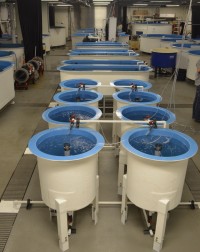
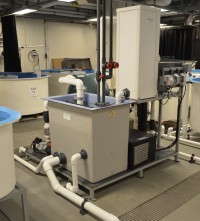
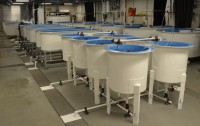
Oceans Design Inc. was hired by the NOAA to alleviate difficulties they were having with supersaturated water supplied from their newly installed flow through filtration system. The problem was quickly identified as undersized degassing columns. Oceans Design fabricated wall mount degassing columns at a hydraulic flow rate appropriate for both the level of supersaturation they were experiencing and the maximum flow rates they anticipated. Saturation levels of 100% TGP were achieved immediately following installation.
Following the success of the previous project Oceans Design Inc. was contracted by NOAA to design and fabricate a turn key, skid mounted filtration system designed for white abalone an endangered species in California. Oceans Design Inc. provided a comprehensive planning package which included a 3D model of the entire lab which enabled NOAA engineers to predict weight loadings and view the proposed system before it was installed. Oceans Design Inc. continues to provide NOAA with consulting and design services as well as high quality equipment to meet their demands.
IOWA DEPT. OF NATURAL RESOURCES
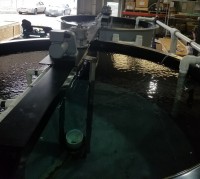
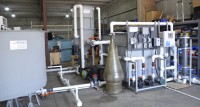

Oceans Design designed and manufactured a larval recirculation system for Iowa Department of Natural Resources with two 2.4m 3 self cleaning larval tanks. The system was designed around culture techniques to raise walleye, a fresh water fish which requires a high feed rate and a propensity for cannibalism. The challenges associated with recirculating larval systems are immense as disinfection processes and fine solids removal are hyper critical and the green water, or in this case clay, to provide turbidity for the larvae are counteractive. Our UV intensity had to be high and solids removal processes efficient. Due to the fact this was a fresh water system, foam fractionation was not an option like in our marine systems. The self cleaning tanks provided a great benefit eradicating a great percentage of the solids before they could even get to the filtration system.
JT MARICULTURE
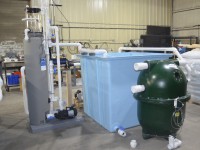
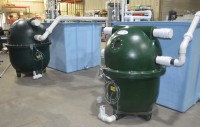
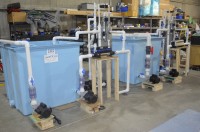
JT Mariculture is located in Minnesota. Not the first place you would look for a shrimp hatchery. Oceans Design designed and fabricated 3 recirculating systems for JT Mariculture, for brood stock, larval, and shrimp grow out life stages. The systems utilize Poly-geyser bead filters as well as vertical moving beds for solids removal and nitrification. In line heaters along with ambient air temperature control maintain temperatures optimal for shrimp. A foam fractionator and UV sterilizer provide dissolved solids removal and disinfection respectively. Shrimp are raised in fiberglass tanks provided by our sister company Gemini Fiberglass. JT Mariculture elected to install the systems themselves to save on capital cost. Having 10,000 ft 2 of manufacturing helps greatly so we can put these systems together as they would sit in their intended space making the installation very easy for our costumers who want to do these installations themselves.
NATCHITOCHES NATIONAL FISH HATCHERY
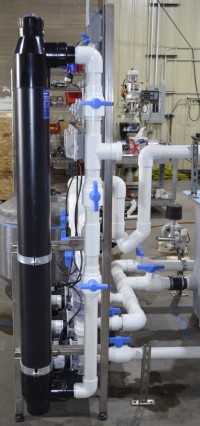
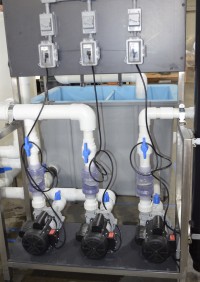
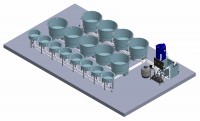
Oceans Design designed a recirculating aquaculture system for Natchitoches National Fish Hatchery located in Louisiana. The tanks we're already in place but operating as flow through. A compact modular design was selected and a detail plumbing drawing provided to the hatchery as they we're installing the systems themselves.
Oceans Design uses SolidWorks, a 3-D and 2-D modeling program to design all its systems. This allows us to create a true scale model of the system and space allowing customers to see how the system will fit into its space and then a detailed drawing set is created from the model. The 3-D model we generated for Natchitoches NFH can be seen in picture 1.
The system included a media filter with a specialized media to filter water to 5 microns. A vertical moving bed was used for nitrification and the a UV sterilizer for disinfection. The system was simple, straight forward and accomplished the goals set forth ny the hatchery.
INSTITUTO DE DESARROLLO ACUICOLA DE BAJA
BAJA SEAS YELLOWTAIL FISH HATCHERY, BAJA MEXICO
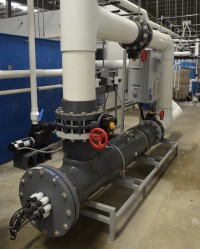
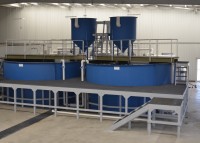
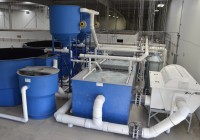
Oceans Design was hired to alleviate problems the hatchery was experiencing with poor water quality from its sea water intake filtration system. The system was to supply filtered sea water throughout the hatchery and included additional filtration to supply their larval system with the highest quality of flow through sea water.
Oceans Design established design criteria to filter incoming sea water down to 5 microns using media filters with a computer control system and our yellowtail specific sterilization and polishing filtration system to supply both the larval and live feeds areas with top tier filtered sea water. The subsequent larval run resulted in a survival rate of 45% up from an average of 5% experienced in previous runs.
Upon successful completion of the sea water intake filtration system Oceans Design was commissioned to design, manufacture, and install a 1200 gpm juvenile system for Seriola lalandi (California yellowtail). The system was designed based on a daily feed rates up to 10% body weight per day. A run of juvenile Seriola lalandi is planned for in January.
|
|